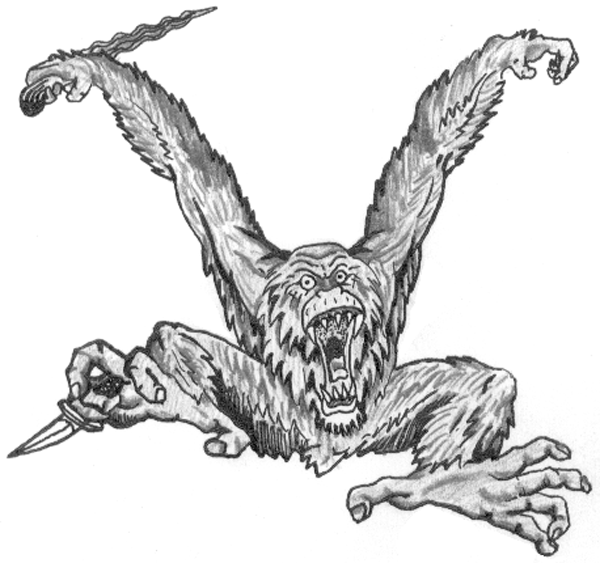 Heartless
Monkey has no 'second thoughts'; no compassion, no regret, no remorse,
no reservations. Heartless Monkey has no regard for your humanity;
your unique status as a Human Being deserving of anything, he sees you
as a snake.
Heartless
Monkey has no 'second thoughts'; no compassion, no regret, no remorse,
no reservations. Heartless Monkey has no regard for your humanity;
your unique status as a Human Being deserving of anything, he sees you
as a snake.
 Heartless
Monkey has no 'second thoughts'; no compassion, no regret, no remorse,
no reservations. Heartless Monkey has no regard for your humanity;
your unique status as a Human Being deserving of anything, he sees you
as a snake.
Heartless
Monkey has no 'second thoughts'; no compassion, no regret, no remorse,
no reservations. Heartless Monkey has no regard for your humanity;
your unique status as a Human Being deserving of anything, he sees you
as a snake.
It is usually a small knife; sometimes single edged, sometimes
double- always very sharp, very pointed, sometimes carried in sets
or singles carried around the body. Most of the time, the knife is
carried in the front of the body, on either side of the navel. The
sheath serves as extra armor, the closed knife can be used as a small hand
stick and the movements to access the knife are naturally to the center
of the body.
Think of the monkey- he screams and capers, plucking,
pulling and twisting, always in motion. He doesn't react to attack
or pain or fright. He attacks heartlessly, pitilessly, without regard
for his opponent.
The monkey sylings of Indonesian Silat; Ketchak, Monjet, TjiNgkrik and so forth, characterize various of the primates, and those primates in different personae. The large apes are seen as practitioners with heavy arms, pulling with the waist, short planted steps, strikes with the ends of the bones, very positional fighters. In contrast, the small monkey practitioners utilize light penetrating motion, capering and leaping in and out, plucking and grabbing, precision targeting of vulnerable points. The vicious actions of wild monkeys attack the eyes, groin, throat and face. The arms, hair, ears, loose flesh and fingers are used as handles and for distracting pain points to open other targets.
 The
knives of the monkey stylings range from the 'pisau', a light utility knife,
to the golok, a heavy cleaver type. The 'badik' and the 'rentjoeng'
are sharp pointed, slashing knives with short curved handles for positive
hold. The King of knives is the Kris; a slashing, stabbing knife
which depends upon its' shape for its' utility.
The
knives of the monkey stylings range from the 'pisau', a light utility knife,
to the golok, a heavy cleaver type. The 'badik' and the 'rentjoeng'
are sharp pointed, slashing knives with short curved handles for positive
hold. The King of knives is the Kris; a slashing, stabbing knife
which depends upon its' shape for its' utility.
The unique hold of the small knife and the styling that
most characterizes the monkey styling is the 'palming' of the knife.
The butt of the knife is snuggled into the 'V" of the palm with the point
and spine following the line between the forefinger and middle finger.
This will line the point on the axis of the entire forearm, reinforcing
the insertion of the knife into the opponent. This hold lengthens
a short knife by moving it farther along the hand than the common European
hold known as the Sabre Grip. As the point is planted, the palm hits
the butt of the knife to drive the end below the surface of the body.
The practitioner then manipulates the body into a lot of movement to maximize
the wound channel inside.
A furious barrage of wounding attacks to the opponent will give him no opportunity to attack, only to react. A series of small wounds damages him psychically as well as physically. Unless your opponent is a deeply trained man of great mental discipline, he will feel the effect of small wounds as if they were great ones. It is the idea of being 'breached' that is so intimidating.
The 'displante' of moving the opponent along his weakest
ground meridians by forcing a foot movement is the first step to taking
his head. His strengths are being displayed by the choice of stance
and posture that he is using-to force him to change that is to challenge
his tactic and raise questions in his mind about his next move. His
reaction time slows down with the number of decisions to be made.
Chas Clements
1741 Dallas Street
Aurora, Colorado
80010-2018
303-364-0403 home
303-739-9824 fax
E-Mail to: Chas
www.geocities.com/betawimuda/chas.mpg